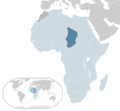Chad Energy Situation
Capital:
N'Djamena
Region:
Coordinates:
12.1000° N, 16.0333° E
Total Area (km²): It includes a country's total area, including areas under inland bodies of water and some coastal waterways.
1,284,000
Population: It is based on the de facto definition of population, which counts all residents regardless of legal status or citizenship--except for refugees not permanently settled in the country of asylum, who are generally considered part of the population of their country of origin.
17,723,315 (2022)
Rural Population (% of total population): It refers to people living in rural areas as defined by national statistical offices. It is calculated as the difference between total population and urban population.
76 (2022)
GDP (current US$): It is the sum of gross value added by all resident producers in the economy plus any product taxes and minus any subsidies not included in the value of the products. It is calculated without making deductions for depreciation of fabricated assets or for depletion and degradation of natural resources.
12,704,149,840 (2022)
GDP Per Capita (current US$): It is gross domestic product divided by midyear population
716.80 (2022)
Access to Electricity (% of population): It is the percentage of population with access to electricity.
11.27 (2021)
Energy Imports Net (% of energy use): It is estimated as energy use less production, both measured in oil equivalents. A negative value indicates that the country is a net exporter. Energy use refers to use of primary energy before transformation to other end-use fuels, which is equal to indigenous production plus imports and stock changes, minus exports and fuels supplied to ships and aircraft engaged in international transport.
no data
Fossil Fuel Energy Consumption (% of total): It comprises coal, oil, petroleum, and natural gas products.
no data
Introduction
Energy Situation
- Find relevant information for Chad on energy access (access to electricity, access to clean cooking, renewable energy and energy efficiency) on the Tracking SDG7 homepage. (Sustainable Development Goal indicators 7.1 energy access, 7.2 on renewable energy and 7.3 on energy efficiency)
- Find a summarized energy profile for Chad (Atlas of Africa Energy Sources)
Renewable Energy
- Find relevant data on Renewable Power Capacity and Generation of COUNTRY at the homepage of IRENA.org.
Fossil Fuels
Key Problems of the Energy Sector
"Chad's fragile security environment is an overarching barrier to project development. Additionally, the lack of incentivizing legal framework, finance and transparency further diminishes the country's attractiveness to investors. The grid is in need of improvement and expansion prior to adding significant new-build. This has slowed down the development of the Djermaya Solar plant, for example. The state utility SNE is unable to recover its costs due to the mandated price subsidies as outlined above, but seems to have been able to meet its contractual obligations so far."[1]
USAID Power Africa states the following bottlenecks as the biggest for Chad's energy sector[2]:
- Lacking access to Financing
- Lacking creditworthiness of utilities
- Insecurity and governance
Policy Framework, Laws and Regulations
- Climatescope 2019 lists the clean energy policies and investments for Chad. So far, Chad has been slow to set up renewable energy incentives.
- RISE scores reflect a snapshot of Chad’s policies and regulations in the energy sector, organized by the three pillars of sustainable energy: Energy Access, Energy Efficiency, and Renewable Energy.
- Find an overview of the electrification investment scenarios (2025 and 2030) for Chad on the Global Electrification Platform (GEP).
- Find relevant information on the regulations and Chad's strategy in the energy sector at the homepage of the African Energy Portal.
Institutional Set up in the Energy Sector
The government created the Agency for the Development of Renewable Energy (ADER) within the Ministry of Petroleum and Energy, which is accountable for renewables-based electrification, among other responsibilities.[3]
Other Key Actors / Activities of Donors, Implementing Agencies, Civil Society Organisations
Further Information
- USAID Power Africa: Chad Factsheet
References
- ↑ Climatescope 2019. Chad. Accessed 2.6.2020 http://global-climatescope.org/results/TD#barriers
- ↑ Power Africa. (2018). Chad Factsheet. Retrieved from: https://www.usaid.gov/sites/default/files/documents/1860/ChadPACFSDEC2017.pdf
- ↑ Climatescope 2019. Chad. Accessed 2.6.2020 http://global-climatescope.org/results/TD#barriers





















